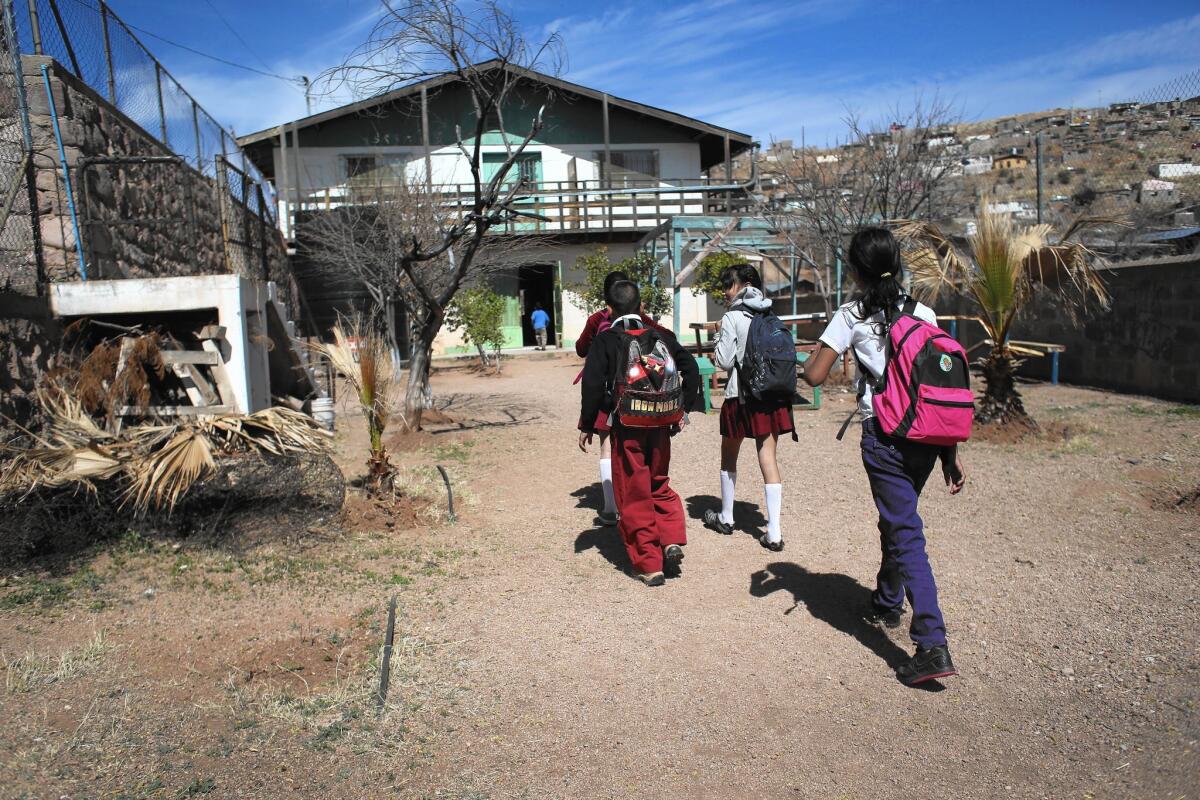U.S.-born students in Mexico risk becoming ‘lost generation’

Emmanuel Vargas was 13 and just starting eighth grade in Davenport, Iowa, when his father was detained in a workplace immigration raid and deported back to Mexico.
His parents decided they should stick together, and the whole family, including Emmanuel and his 15-year-old sister, both born in Iowa, moved to Leon, in the central state of Guanajuato.
It was a culture shock for the full-fledged American teenagers, who spoke fluent English and broken Spanish. Their parents assured them that things would get easier once they enrolled in school and made new friends. But with one bureaucratic delay after another, it took a full year for the Mexican school to process their enrollment.
“It was really hard sitting at home for so long with nothing to do,” said Emmanuel, now 17. “I … got left behind.”
After deportations increased and the U.S. economic downturn caused more families to return home, the number of U.S. citizens enrolled in Mexican schools almost doubled over the last three years, with the total now nearing 450,000.
The transition for these American-born students is often no easier than that of Mexican immigrants entering U.S. schools — and often it is worse. Many encounter long delays in enrollment. Once admitted, many struggle to learn Spanish or have trouble adjusting to a new classroom culture and teaching methods.
Only 10% of primary schools and about 40% of secondary schools have English-speaking teachers, according to a recent study by the nonprofit organization Mexicanos Primero.
Concern is growing on both sides of the border about a potential “lost generation” of youngsters who once considered themselves American.
“This is a large, growing, very vulnerable and definitely a high-risk population which is a huge priority for the United States,” said Karin Lang, chief of American Citizen Services at the U.S. Embassy in Mexico City. “Both countries have an interest in getting them into education. If we don’t, they are at high risk from organized criminal groups. We know many will return to the U.S. when they are old enough.”
Already, Lang said, “we are aware of an increasing number of these young [U.S.] citizens in Mexico’s juvenile prisons.”
Researcher Monica Jacobo says that inadequate educational opportunities means overlooking a potentially huge pool of linguistic talent that could help resolve Mexico’s English teacher deficit.
“There are huge social and economic implications for Mexico in losing these bilingual and bicultural young people in the context of globalization and its ongoing interdependency with the U.S.,” said Jacobo, who analyzes data for the Mexico-based Interdisciplinary Program on Educational Policy and Practice. “They should be seen as an asset, not a problem.”
The problem’s scope became evident when the Institute for Women in Migration started receiving complaints four years ago from women who were contemplating sending their children back to the U.S. because they had been rejected by Mexican schools for not having what were regarded as the proper documents.
Most children arrive in Mexico with only their U.S. birth certificate and school transcripts and have not been registered as dual nationals before departing the United States. Some parents don’t know what documentation is needed and others are afraid to undertake the process because they are in the country illegally.
Mexico requires foreign documents to have an Apostille, or official certification, to prove they are genuine. Historically in Mexico, people have used school diplomas for identification, so the stamp was one way of reducing fraud.
Each U.S. state has different requirements for obtaining the correct stamps. The process can be expensive and time-consuming and requires Internet access and skills that many returning parents lack.
In the case of Emmanuel and his sister, local high schools refused to accept them until their U.S. birth certificates and school transcripts were sent back to Iowa for authentication and then translated into Spanish by a government-approved agent. The process took a year.
Emmanuel believed that his English skills were deteriorating and knew that his former friends back in Iowa — not to mention the teenagers around him in Mexico — were leaving him behind.
The migration institute discovered high concentrations of U.S.-born children missing months of school or dropping out after returning to Tamaulipas, Baja California, Chihuahua, Sonora, Guanajuato and Jalisco.
In 2013, the institute petitioned Mexican authorities to provide all children with equal access to basic public education without requiring the stamp.
Gretchen Kuhner, director of the institute, said, “We know families who just keep trying different schools, sometimes in different states, until their kid is accepted somewhere. This is ridiculous, we’re talking about school, a child’s education. It should not be this hard.”
“We’ve had around 15 meetings now with the Education, Foreign and Interior ministries, and everyone recognizes this is a huge problem,” Kuhner said. “This is about bureaucratic inertia. It needs someone very high up who can see a political advantage in dealing with these transnational kids to sort it out.”
A meeting on the issue in December included representatives of more than a dozen government agencies and civil society groups. A commission has also been formed to consider remedies.
The federal education department will soon launch a campaign reminding schools of their obligation to admit every child.
Jessica Lopez of the Migrant Policy Unit, which is coordinating government efforts, said, “It’s a problem that must be resolved now, it cannot wait, as the number is increasing all the time. We must find solutions this year.”
Jacobo, the researcher, believes the actual number of children without adequate educational access could be nearer to 1 million.
Official figures fail to include those rejected by schools or returnees who had migrated to the U.S. as young children and now struggle to learn in Spanish.
“Teachers urgently need training on how to teach children for whom Spanish is a second language, as even with the right support, it can take years to become language competent,” Jacobo said. “There are interesting small projects in some states like Tamaulipas, but it’s likely we’re going to lose this generation of returnees.”
Emmanuel, who wants to study medicine, has found the sciences particularly difficult in Spanish and misses the discussion-oriented interactive classes he enjoyed in Davenport.
“It is getting easier as my Spanish is better,” he said. “But I still feel like I am behind.”
Lakhani is a special correspondent.
More to Read
Start your day right
Sign up for Essential California for news, features and recommendations from the L.A. Times and beyond in your inbox six days a week.
You may occasionally receive promotional content from the Los Angeles Times.






